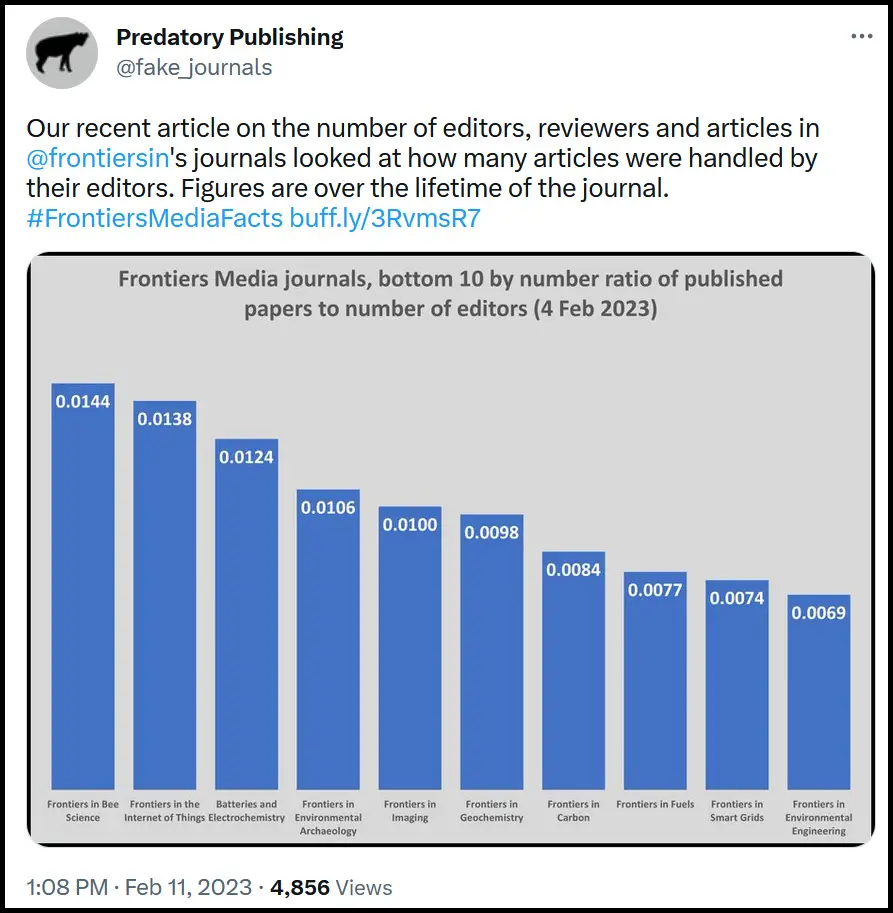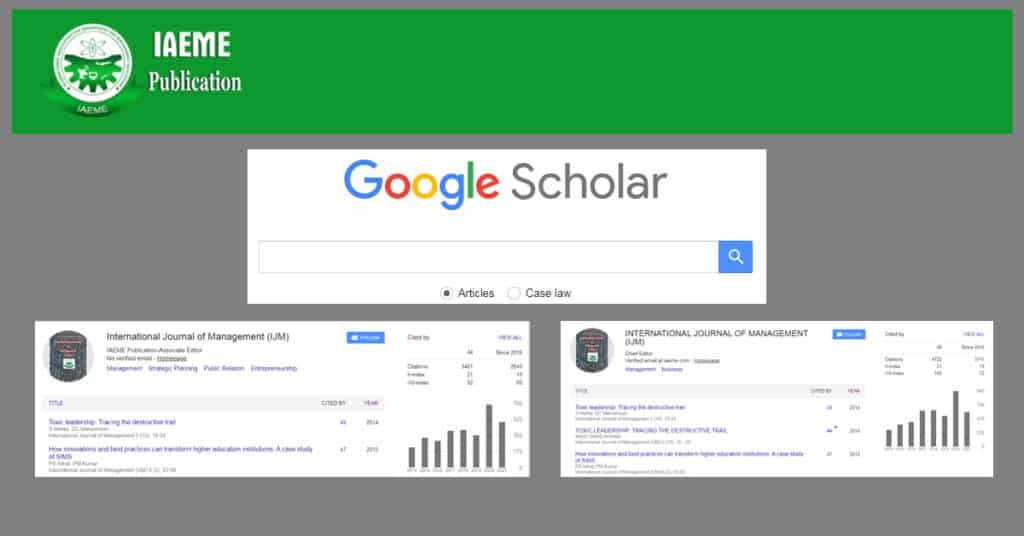In a recent article, we discussed the number of editors, reviewers and articles for Frontiers Media journals.
If you have not read that article, it would be worth taking a look at it first, as this article responds to some of the comments that were made in response to the article when we tweeted about it.
Before we start
In this article we focus on the comments made on Twitter but we would also point you to a couple of other resources, in case you want to dig a little deeper yourself.
- You may want to take a look at our Twitter feed, specifically those posts that have the hashtag #FrontiersMediaFacts. You can see these tweets here.
- We created a page that captured the number of articles and editors, and the ratio between the two, for each Frontiers Media journal, as we could not present every journal in the article itself. We also wanted to create a snapshot on a given date (4 February 2023) , if for nothing else, the historic record. You can see this page here.
The Tweet
It was this tweet (see Figure 1) that generated the discussion that we present in this article. You can see from the Twitter statistics that it has been viewed over 5,000 times (at the time of writing). This is high number of views for our Twitter feed.
Figure 1 shows the number of articles that we calculated have been handled by each “Editor” over the life time of the journal. This is the bottom ten. We also reported the top ten in the article, and also every journal on a separate page.
We suggested that this is low, as every editor had handled (a lot) less than one paper, suggesting that some editors had not handled any papers.
We noted that Frontiers Media lists reviewers (which they call “Review Editors“) as part of the editorial board. This does skew the statistics/calculations, which is a point made by a former Editor-in-Chief (see discussion #03).
Below, we present some of the discussion that took place on Twitter. We have divided the comments into separate discissions, in order to try and reflect the different strands, although the comments all part of the same thread. If you want to see the whole discussion, take a look at the tweet.
We have not identified any names (although we have marked our responses as PP, to identify our comments), as they may not want to be named here, but we have provided a link to the tweet, so you can see who it is, assuming that the tweet remains active.
We provide the full text of the discussion, as not everybody will have access to Twitter.
Discussion #01
#1-01: “I think that the problem here is because @FrontiersIn names its reviewers as Review Editors, providing the total number of reviewers in the pipeline they have. Other editorials don’t give this information. You cannot make that calculation, it’s wrong” (Link to tweet)
#1-02 (PP): “… but they are listed under the “Editorial Board”, which suggests that they are editors – which they are not. Surely, the journal/publisher should be more transparent?” (Link to tweet)
#1-03: “they are even more transparent than other journals, since they show the numbers of all scientists involved in the process: editing and reviewing” (Link to tweet)
#1-04 (PP): “… but list them under the editorial board. Agree that are calculations may be wrong but we don’t have access to the number of submitted papers and we only looked at the editorial board. I suppose it’s all about the lens you are looking through.” (Link to tweet)
Comments
The point we were trying to make, both in the article and in our responses in the above Twitter discussion, is that we accept that Frontiers Media lists their reviewers as part of their editorial team, but this is not the way that most journals do this. The editorial board are the people that handle the papers and the reviewers are not usually listed as part of the Editorial Board.
We have no problem with Frontiers Media doing this, but they might want to be a little more transparent? For example, splitting the tab on the journal web site into “Editors” and “Reviewers” or at least making that distinction when they show the number of editors. As an example, Figure 2, shows the number of editors for Frontiers in Aging, but a proportion of these 964 people will be reviewers and do not actually handle papers so we would not consider them editors. Is that wrong?
Discussion #02
#2-01: “This is certainly interesting. But I have no context for whether this is normal. Are these tiny ratios just a trick of semantics? Always good to have a set of control and *comparable* publishers in analysis so it’s not just a focused bashing. Thus why poll had PLOS, BMC etc.” (Link to tweet)
Note: The poll refers to a recent poll that the author held. You can access the poll here.
#02-2 (PP): “The people we know (small sample size) handle a few (2-3 would be small, 5 average, 10 quite a lot) papers a year. Anything below zero (in a year) would be seen a a VERY light workload. Anything below zero, would be seen as a VERY, VERY light workload. All, just our perspective.” (Link to tweet)
#02-3: “Of course! But that’s not in the article (& it’s subjective) It’s great motivation to do an investigation like this. But without that info in the article (in an itemized/systematic fashion), I end the article in a black box, rather than emerging from one.” (Link to tweet)
#02-4 (PP): “We did think of that but the stats we presented are factual. If we compare those against what “we feel/believe” it could be criticized as an unfair comparison. What we’ll try and do is compare against other journals – but that is a whole chunk of work.” (Link to tweet)
#02-5: “Whole chunk of work, but worth it!” (Link to tweet)
Comments
This is a fair point (to have a comparison against some other journals). We were not kidding though when we said that it be a whole chunk of work, but we’ll work on this over the coming weeks.
Ideally, we’d like to publish the findings as a peer reviewed paper. This is for a couple of reasons.
Most importantly, it enables others (i.e. the peer reviewers and editors) to comment on the paper, it’s findings and the conclusions drawn. This gives the paper (some) validity.
Perhaps as important, we all need to publish papers and if we are addressing a question that seems to be relevant and which many people would care about, then why not write it a paper and subject the findings to peer review.
Discussion #03
#03-1: “I can give you the example of Frontiers in Marine Science, in which I was Specialty Chief Editor until past December, for 10 years. The Section is Marine Ecosystem Ecology. I have not the information of the whole journal (Frontiers in Marine Science). see the thread below:” (Link to tweet)
#03-2: “
- 1 Specialty Chief Editor
- 40 Associate Editors
- 342 Review Editors (other journals named them reviewers), and these are those in the registered in the database, to be invited for review (also other external) Follow tread“
#03-3: “
- In 2022 we received 367 manuscripts
- Divided by 40 editors, each of them handled 9.2 papers (this could change if there are guest editors)
- Of course, not all Review Editors reviewed papers in 2022, but this is as in other journals
Hence, your calculations are wrong” (Link to tweet)
#03-5 (PP): “Thanks for the clarification” (Link to tweet)
#03-6 (PP): “We will update our article to reflect what you have said – thank you. We appreciate that you have provided the information you have.” (Link to tweet)
Comments
We appreciate this information. We agree that that our figures could be calculated differently, given the above information.
However, we still maintain that the information is not presented as transparently as it could be, in that editors and reviewers are all listed under the “Editorial Board” tab, suggesting that all those listed are editors. Moreover, the reviewers are listed as “Review Editors”, which could be interpreted as them having some editorial function, rather than being just reviewers.
With reference to our previous article, we also note one example, where a reviewer had not reviewed a paper for the past five years, yet are still listed an Review Editor. There is nothing particularly wrong with that, but somebody looking at the web site may assume that all those listed have an active role.
Finally, it is far from easy to ascertain the number of editors and (review) editors. The web pages are such that as you scroll down the page, more information is provided. If a journal has (say) 15,000 people listed (as some do) it is not easy – and certainly time consuming – to look at all those people, let alone find out how many are editors and how many are review editors.
Final comments and an invitation
We accept that the material we presented in our previous article was an interpretation which could be framed in different ways.
However, we would say:
- All of the people are listed under an “Editorial Board” tab on the web site, but they are not all editors as most scholars would understand the term.
- When you look at the home page of a journal it says how many editors there are. The word “Editors” is used which a reader might assume that they are all editors and not reviewers.
- It is unusual for journals to list all the editors and reviewers on the same page. Frontiers Media also appears to list all of their reviewers, both current and historic. There is nothing wrong in doing this, but most journals don’t and it might be useful if Frontiers Media made this clearer than they currently do.
We accept that the way we have interpreted the data is open to debate but we hope this article explains why we interpreted the data as we did.
Moreover, if Frontiers Media are willing to provide a breakdown of the editorial types for each journal, we will happily redo the analysis and present those results. We would like to collect the data ourselves but as we note above, this is problematic due to the way the web site presents this information.
An invitation
If anybody from the publisher (either from Frontiers Media or one of its Editor-in-Chiefs) is reading this article, we would welcome an article from them, which explains how their system works. We would be happy to work with you to publish the article “as-submitted”, with just a few due diligence checks. You can reach us as admin@predatory-publishing.com.




